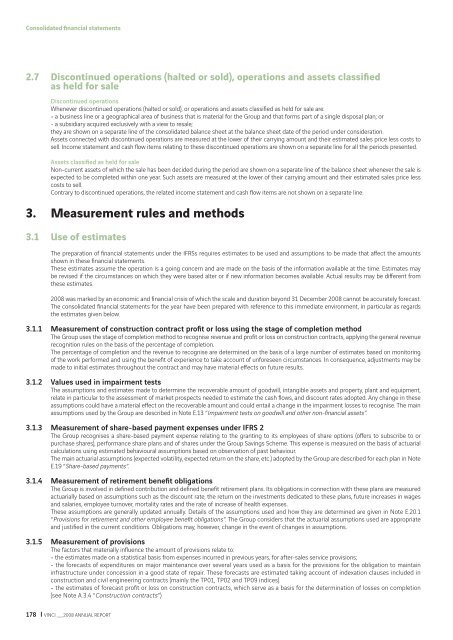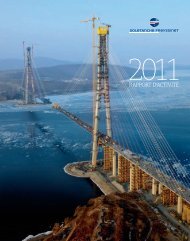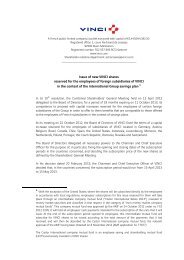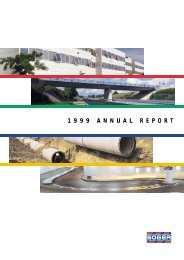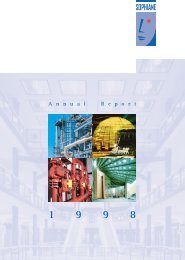VINCI - 2008 annual report
VINCI - 2008 annual report
VINCI - 2008 annual report
You also want an ePaper? Increase the reach of your titles
YUMPU automatically turns print PDFs into web optimized ePapers that Google loves.
Consolidated fi nancial statements<br />
2.7 Discontinued operations (halted or sold), operations and assets classifi ed<br />
as held for sale<br />
Discontinued operations<br />
Whenever discontinued operations (halted or sold), or operations and assets classifi ed as held for sale are:<br />
- a business line or a geographical area of business that is material for the Group and that forms part of a single disposal plan; or<br />
- a subsidiary acquired exclusively with a view to resale;<br />
they are shown on a separate line of the consolidated balance sheet at the balance sheet date of the period under consideration.<br />
Assets connected with discontinued operations are measured at the lower of their carrying amount and their estimated sales price less costs to<br />
sell. Income statement and cash fl ow items relating to these discontinued operations are shown on a separate line for all the periods presented.<br />
Assets classifi ed as held for sale<br />
Non-current assets of which the sale has been decided during the period are shown on a separate line of the balance sheet whenever the sale is<br />
expected to be completed within one year. Such assets are measured at the lower of their carrying amount and their estimated sales price less<br />
costs to sell.<br />
Contrary to discontinued operations, the related income statement and cash fl ow items are not shown on a separate line.<br />
3. Measurement rules and methods<br />
3.1 Use of estimates<br />
The preparation of fi nancial statements under the IFRSs requires estimates to be used and assumptions to be made that aff ect the amounts<br />
shown in these fi nancial statements.<br />
These estimates assume the operation is a going concern and are made on the basis of the information available at the time. Estimates may<br />
be revised if the circumstances on which they were based alter or if new information becomes available. Actual results may be diff erent from<br />
these estimates.<br />
<strong>2008</strong> was marked by an economic and fi nancial crisis of which the scale and duration beyond 31 December <strong>2008</strong> cannot be accurately forecast.<br />
The consolidated fi nancial statements for the year have been prepared with reference to this immediate environment, in particular as regards<br />
the estimates given below.<br />
3.1.1 Measurement of construction contract profi t or loss using the stage of completion method<br />
The Group uses the stage of completion method to recognise revenue and profi t or loss on construction contracts, applying the general revenue<br />
recognition rules on the basis of the percentage of completion.<br />
The percentage of completion and the revenue to recognise are determined on the basis of a large number of estimates based on monitoring<br />
of the work performed and using the benefi t of experience to take account of unforeseen circumstances. In consequence, adjustments may be<br />
made to initial estimates throughout the contract and may have material eff ects on future results.<br />
3.1.2 Values used in impairment tests<br />
The assumptions and estimates made to determine the recoverable amount of goodwill, intangible assets and property, plant and equipment,<br />
relate in particular to the assessment of market prospects needed to estimate the cash fl ows, and discount rates adopted. Any change in these<br />
assumptions could have a material eff ect on the recoverable amount and could entail a change in the impairment losses to recognise. The main<br />
assumptions used by the Group are described in Note E.13 “Impairment tests on goodwill and other non-fi nancial assets”.<br />
3.1.3 Measurement of share-based payment expenses under IFRS 2<br />
The Group recognises a share-based payment expense relating to the granting to its employees of share options (off ers to subscribe to or<br />
purchase shares), performance share plans and of shares under the Group Savings Scheme. This expense is measured on the basis of actuarial<br />
calculations using estimated behavioural assumptions based on observation of past behaviour.<br />
The main actuarial assumptions (expected volatility, expected return on the share, etc.) adopted by the Group are described for each plan in Note<br />
E.19 “Share-based payments”.<br />
3.1.4 Measurement of retirement benefi t obligations<br />
The Group is involved in defi ned contribution and defi ned benefi t retirement plans. Its obligations in connection with these plans are measured<br />
actuarially based on assumptions such as the discount rate, the return on the investments dedicated to these plans, future increases in wages<br />
and salaries, employee turnover, mortality rates and the rate of increase of health expenses.<br />
These assumptions are generally updated <strong>annual</strong>ly. Details of the assumptions used and how they are determined are given in Note E.20.1<br />
“Provisions for retirement and other employee benefi t obligations”. The Group considers that the actuarial assumptions used are appropriate<br />
and justifi ed in the current conditions. Obligations may, however, change in the event of changes in assumptions.<br />
3.1.5 Measurement of provisions<br />
The factors that materially infl uence the amount of provisions relate to:<br />
- the estimates made on a statistical basis from expenses incurred in previous years, for after-sales service provisions;<br />
- the forecasts of expenditures on major maintenance over several years used as a basis for the provisions for the obligation to maintain<br />
infrastructure under concession in a good state of repair. These forecasts are estimated taking account of indexation clauses included in<br />
construction and civil engineering contracts (mainly the TP01, TP02 and TP09 indices).<br />
- the estimates of forecast profi t or loss on construction contracts, which serve as a basis for the determination of losses on completion<br />
(see Note A.3.4 “Construction contracts”)<br />
178 <strong>VINCI</strong> __ <strong>2008</strong> ANNUAL REPORT


